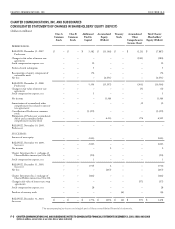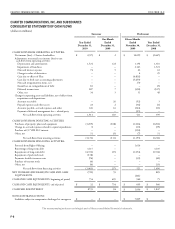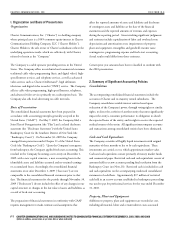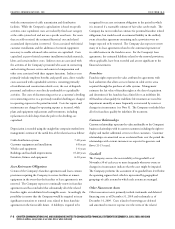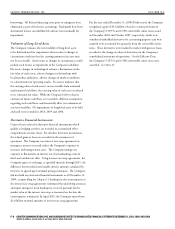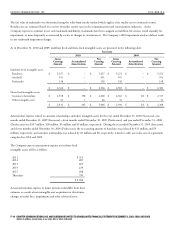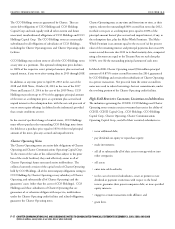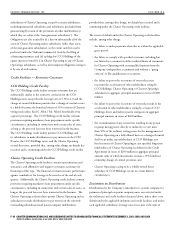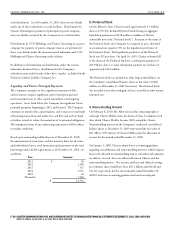Charter 2010 Annual Report Download - page 96
Download and view the complete annual report
Please find page 96 of the 2010 Charter annual report below. You can navigate through the pages in the report by either clicking on the pages listed below, or by using the keyword search tool below to find specific information within the annual report.
F- F-PB
CHARTER COMMUNICATIONS, INC. AND SUBSIDIARIES NOTES TO CONSOLIDATED FINANCIAL STATEMENTS DECEMBER 31, 2010, 2009, AND 2008
(dollars in millions, except share or per share data or where indicated)
Multiple-Element Transactions
In the normal course of business, the Company enters into
multiple-element transactions where it is simultaneously both a
customer and a vendor with the same counterparty or in which it
purchases multiple products and/or services, or settles outstanding
items contemporaneous with the purchase of a product or service
from a single counterparty. Transactions, although negotiated
contemporaneously, may be documented in one or more contracts.
e Company’s policy for accounting for each transaction negotiated
contemporaneously is to record each element of the transaction based
on the respective estimated fair values of the products or services
purchased and the products or services sold. In determining the
fair value of the respective elements, the Company refers to quoted
market prices (where available), historical transactions or comparable
cash transactions.
Stock-Based Compensation
Restricted stock, stock options and performance units and shares
are measured at the grant date fair value and amortized to stock
compensation expense over the vesting period. e Company
recorded $26 million, $1 million, $26 million and $33 million
of stock compensation expense which is included in general and
administrative expenses for the year ended December 31, 2010
(Successor), one month ended December 31, 2009 (Successor),
eleven months ended November 30, 2009 (Predecessor) and year
ended December 31, 2008 (Predecessor), respectively.
e fair value of each option granted is estimated on the date of
grant using the Black-Scholes option-pricing model. e following
weighted average assumptions were used for grants during the years
ended December 31, 2010 (Successor) and 2008 (Predecessor),
respectively; risk-free interest rates of 2.5% and 3.5%; expected
volatility of 47.7% and 88.1%, and expected lives of 6.3 years and
6.3 years, respectively. Volatility assumptions for 2010 were based
on historical volatility of a peer group while volatility assumptions
for 2008 were based on Charter’s historical volatility. e Company’s
volatility assumption for 2010 represents management’s best estimate
and was based on historical volatility of a peer group because
management does not believe Charter’s pre-emergence historical
volatility to be representative of its future volatility. Expected lives
were calculated based on the simplified-method due to insufficient
historical exercise data. e valuations assume no dividends are paid.
e Company did not grant stock options in 2009.
Income Taxes
e Company recognizes deferred tax assets and liabilities for
temporary differences between the financial reporting basis and the
tax basis of the Company’s assets and liabilities and expected benefits
of utilizing loss carryforwards. e impact on deferred taxes of
changes in tax rates and tax law, if any, applied to the years during
which temporary differences are expected to be settled, are reflected
in the consolidated financial statements in the period of enactment
(see Note 18).
Earnings (Loss) per Common Share
Basic earnings (loss) per common share is computed by dividing the
net income (loss) available to common shareholders by the weighted-
average common shares outstanding during the respective periods.
Diluted loss per common share equals basic loss per common share
for the years ended December 31, 2010 and 2008, as the effect of
stock options and other convertible securities are antidilutive because
the Company incurred net losses. Diluted earnings per common
share for the one month ended December 31, 2009 and eleven
months ended November 30, 2009 is based on the average number
of shares used for the basic earnings per common share calculation,
adjusted for the dilutive effect of stock options and other convertible
securities (See Note 19). Predecessor shares were cancelled on the
Effective Date and shares of Successor were issued. As a result,
earnings (loss) per share information for the Successor is not
comparable to the Predecessor loss per share.
e 21.8 million shares outstanding as of December 31, 2008
(Predecessor), pursuant to the share lending agreement described
in Note 10 were required to be returned, in accordance with the
contractual arrangement, and were treated in basic and diluted
earnings per common share as if they were already returned and
retired. Consequently, there was no impact of the shares of common
stock lent under the share lending agreement in the earnings per
common share calculation.
Segments
e Company’s operations are managed on the basis of geographic
operating segments. e Company has evaluated the criteria for
aggregation of the geographic operating segments and believes it
meets each of the respective criteria set forth. e Company delivers
similar products and services within each of its geographic operations.
Each geographic service area utilizes similar means for delivering
the programming of the Company’s services; have similarity in the






